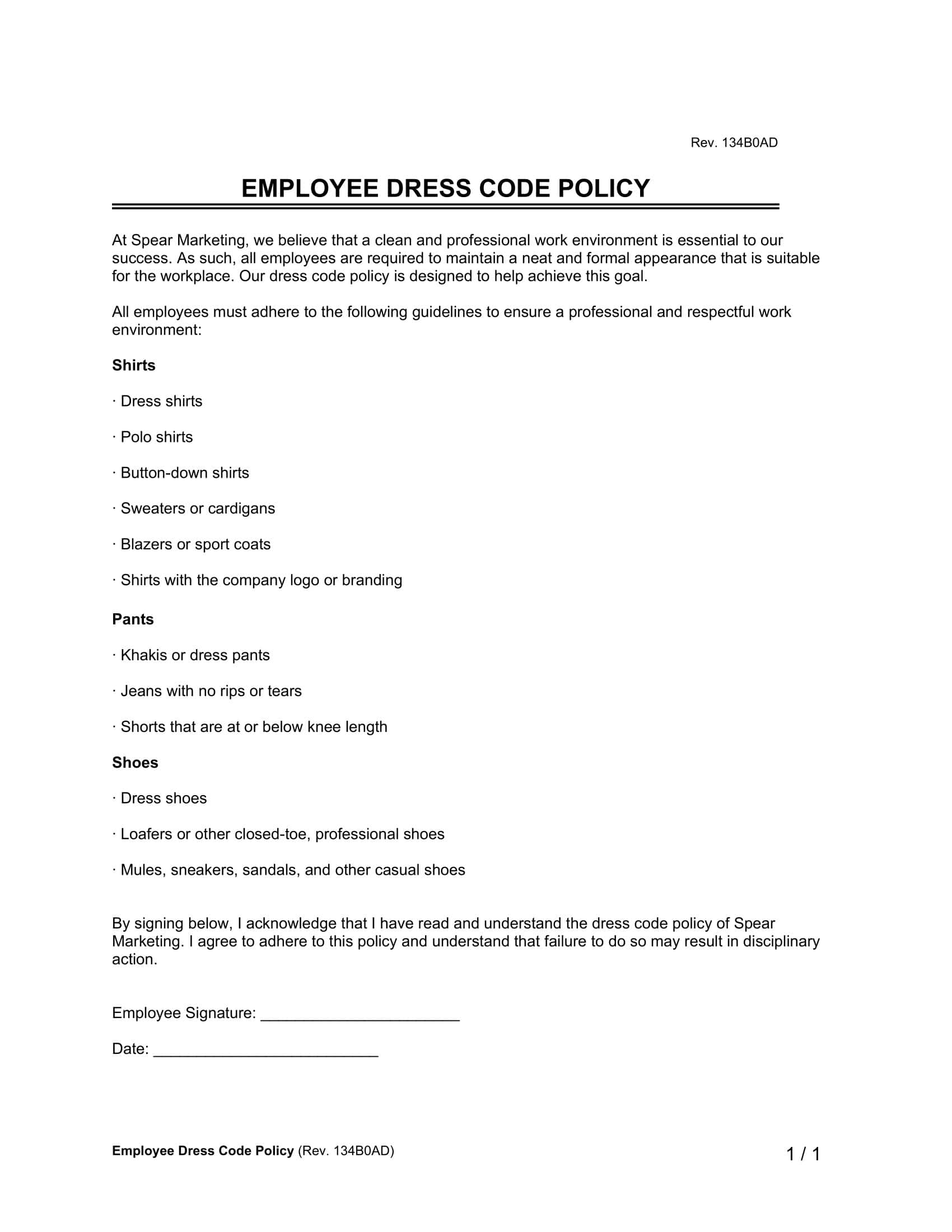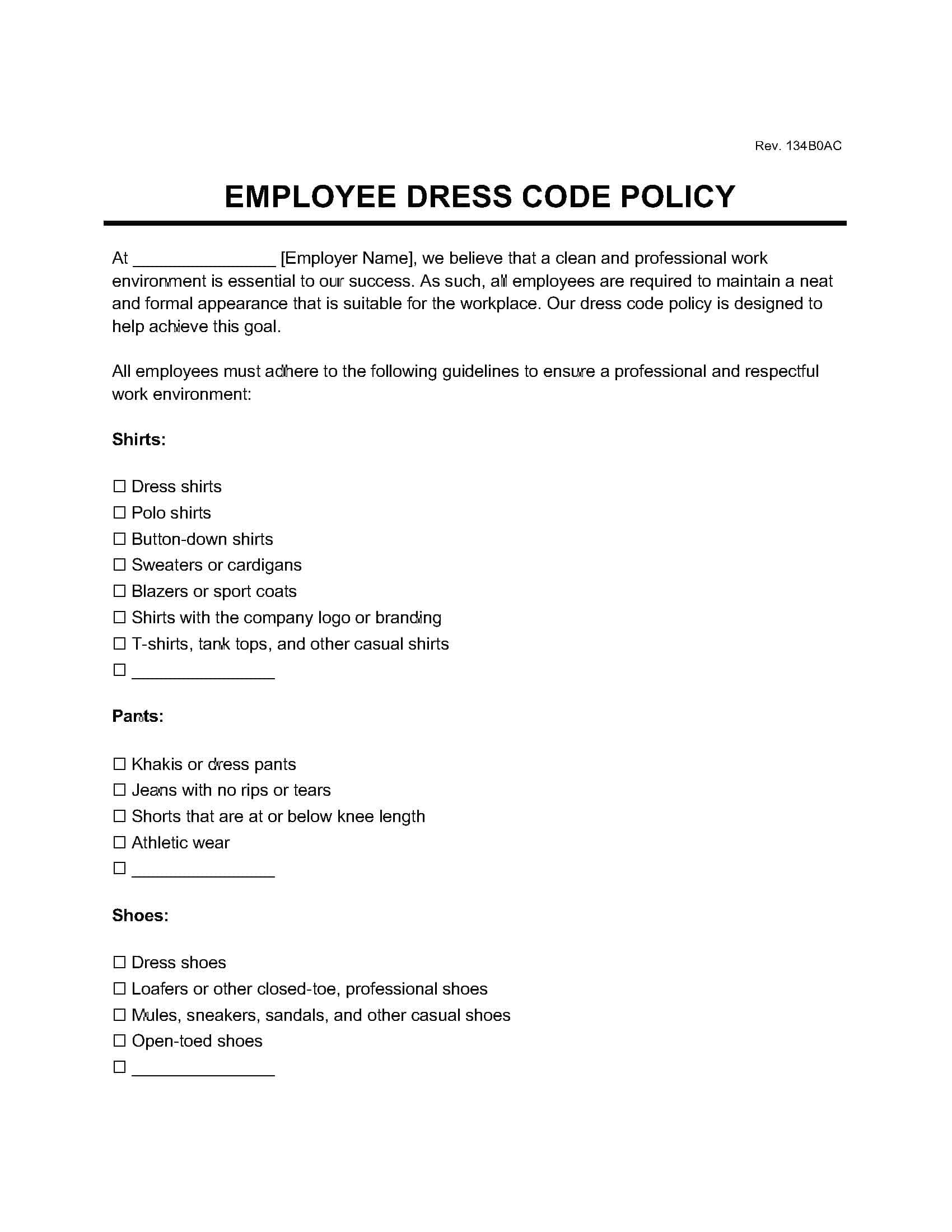What Is a Dress Code Policy?
A dress code policy is a list of guidelines for how employees should present themselves in the workplace. This includes details about the proper clothing, hygiene, and footwear. It may also state whether employees can have visible tattoos, piercings, or facial hair.
Having a company uniform policy in writing makes it easy to provide to new hires and refer to the document as needed. You can also send out a dress code reminder to highlight guidelines that aren’t followed.
Legal Templates offers a customizable dress code policy template for companies. Use our form to communicate how employees should dress for work.
Why Is a Dress Code Policy Significant?
A dress code policy is essential for these reasons:
- Provides clear, consistent guidelines
- Impresses customers and clients with a cohesive, professional image
- Promotes inclusiveness and equity, with a common standard for everyone
- Enhances safety in cases where protective gear or specific clothing is required
- Projects a corporate culture that positively impacts how employees look and feel
How to Write a Dress Code Policy
Knowing how to write a professional dress code policy helps you avoid confusion and disputes. Include all the necessary information with the following steps.
1. Write the Introduction
Start with an introduction of the most essential details. Add the company name and explain who this dress code will apply to. In some cases, all employees adhere to the same policies, but you can also create separate standards for each type of employee. For example, managers may wear more formal business attire while lower-level employees have a more casual dress code.
2. Define the Dress Code
Describe the type of aesthetic and exact articles of clothing acceptable for the role. Choose a kind of attire that matches the scope of the work. Consider defining the policy as business attire, business professional attire, or a business casual dress code.
You can create a list of options for each category of clothing. Consider your desired guidelines for the following items:
- Shirts: Choose whether employees can wear dress shirts, polos, button-downs, sweaters, blazers, or t-shirts.
- Pants: Note the appropriate pants, such as khakis, dress pants, jeans, shorts, or athletic bottoms.
- Shoes: Dictate requirements for dress shoes, loafers, sneakers, sandals, or others.
If your company has a uniform policy, include those details in this part of the document. Also, include any company-issued components or required colors, fits, shoes, or equipment.
Our dress code or uniform policy template has an easy checklist menu so you can select and add the options that work best for your company. Click the acceptable options to add them to your company’s dress code policy.
3. Note Any Exceptions
Note any applicable exceptions to this policy. Include as much detail as possible and aim to be inclusive and accommodating. Examples of common exceptions include:
- Casual Fridays
- Casual attire for company events
- Considerations for individuals with a medical device
- Head coverings for religious practices
Our document editor lets you write in your own exceptions for a customized policy. This allows you to add exceptions that fit your workplace. You can also ensure your employees understand what terms apply to them and any special cases that allow for different attire.
4. Include Enforcement Provisions
Once you have your policy, it’s important to enforce it. Include the process for handling dress code policy violations, such as a verbal warning, employee write-up, or disciplinary action. Communicating these consequences helps with the fair and consistent treatment of employees.
Dress Code Policy Sample
View our free dress code policy sample, available as a PDF or Word download, to see a clear example of how to set dress guidelines for your team.
Employee Dress Code Policy Example
An example of an employee dress code policy can be seen here:

How to Implement a Dress Code Policy
Having a dress code policy is great, but it’s important to implement and enforce it. You can legally implement your dress code if it includes reasonable and non-discriminatory terms. Ensure you consistently apply the dress code and accommodate religious beliefs or disabilities. Check with your state or local laws for further legal requirements.
1. Communicate the Policy
Clearly communicate the dress code policy to all employees. Start by creating a written policy that discusses the purpose, scope, guidelines, and expectations. Then, distribute it to existing and new employees via email, intranet, or hard copy.
During staff meetings, discuss the policy and its rationale. Be sure to provide examples of appropriate and inappropriate attire for different situations or roles. Additionally, allow employees to express their questions and concerns.
2. Enforce the Policy
Enforcing your dress code with the appropriate measures can increase compliance. Outline how you intend to handle violations. This may include sending the employee home to change clothes or disciplinary actions for repeat offenses. You can also use warning notices to provide staff dress code reminders and urge employees to follow the policy. Extreme cases of repeated violations may require a termination letter.
In addition, provide positive reinforcement for employees who adhere to the guidelines. Employee of the month programs can boost morale and motivate others to improve.
3. Update as Needed
The workplace dress code policy can evolve to meet the company’s and industry’s changing needs. Consider inviting questions and feedback from employees and HR. Adjusting the dress code when appropriate boosts morale, safety, and professionalism.
Research, adapt, and communicate changes to keep everyone on the same page. This includes providing the appropriate communication that allows employees to comply with company expectations.


